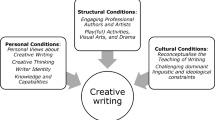Abstract
In 3 second-grade classrooms within diverse educational settings, the theory of culturally responsive teaching was utilized in combination with the strategy, Text Talk. Text Talk is a strategy generally used with young children during read-alouds to foster oral language and comprehension. Culturally response teaching builds on students' prior experiences and knowledge. Together, the use of Text Talk and culturally responsive teaching provides a gateway to support young children's literacy.
Similar content being viewed by others
References
Au, K. H. (1980). Participation structures in a reading lesson with Hawaiian children: Analysis of a culturally appropriate instructional event. Anthropology and Education Quarterly, 11, 91-115.
Beck, I. L., & McKeown, M. G. (2001). Text talk: Capturing the benefits of read-aloud experiences for young children. The Reading Teacher, 55(1), 10-20.
Bradby, M. (1995). More than anything else. New York: Trumpet.
Bus, A. (2001). Joint caregiver-child storybook reading: A route to literacy development. In S. B. Neuman & D. K. Dickinson (Eds.), Handbook of early literacy research (pp. 179-191). New York: The Guilford Press.
Carnahan, S. (Ed.) (1996). Heritage: An African-American quote book. Kansas City, MO: Andrews and McMeel.
Delpit, L. (1995). Other people's children. New York: New Press.
Ferdman, B. (1990). Literacy and cultural identity. Harvard Education Review, 60, 179-204.
Gay, G. (2000). Culturally responsive teaching: Theory, research & practice. New York: Teachers College Press.
Hilliard, A. (1991–1992). Why we must pluralize the curriculum. Educational Leadership, 49(4), 122-126.
Jalongo, M. R. (2003). Early childhood language arts (3rd ed.). Boston: Allyn & Bacon.
Jalongo, M. R., Fennimore, B. S., & Stamp, L. N. (in press). The acquisition of literacy: Reframing definitions, paradigms, ideologies, and practices. In O. Saracho & B. Spodek (Eds.), Contemporary perspectives on language education and language policy in early childhood education. Greenwich, CT: Information Age Publishing.
Ladson-Billings, G. (1994). The dreamkeepers. San Francisco: Jossey-Bass.
Neuman, S. B. (1999a). Books make a difference: A study of access to literacy. Reading Research Quarterly, 34, 286-311.
Neuman, S. B. (1999b). Creating continuity in early literacy: Linking home and school with a culturally responsive approach. In L. B. Gambrell, L. M. Morrow, S. B. Neuman, & M. Pressley (Eds.), Best practices in literacy instruction (pp. 258-270). New York: The Guilford Press.
Neuman, S. B., & Roskos, K. (1994). Bridging home and school with a culturally responsive approach. Childhood Education, 70, 210-214.
Ogle, D. (1986). K-W-L: A teaching model that develops active reading of expository text. The Reading Teacher, 39, 564-570.
Perini, R. L. (2002). The pearl in the shell: Author's notes in multicultural children's literature. Reading Teacher, 55(5), 428-431.
Philips, S. (1972). Participant structures and communicative competence: Warm Springs children in community and classroom. In C. Cazden, V. John, & D. Hymes (Eds.), Functions of language in the classroom (pp. 370-394). New York: Teachers College Press.
Ringgold, F. (1991). Tar beach. New York: Scholastic, Inc.
Whitehurst, G. J., & Lonigan, C. J. (2001). Emergent literacy: Development from prereaders to readers. In S. B. Neuman & D. K. Dickinson (Eds.), Handbook of early literacy research (pp. 11-29). New York: The Guilford Press.
Author information
Authors and Affiliations
Corresponding author
Rights and permissions
About this article
Cite this article
Conrad, N.K., Gong, Y., Sipp, L. et al. Using Text Talk as a Gateway to Culturally Responsive Teaching. Early Childhood Education Journal 31, 187–192 (2004). https://doi.org/10.1023/B:ECEJ.0000012137.43147.af
Issue Date:
DOI: https://doi.org/10.1023/B:ECEJ.0000012137.43147.af




